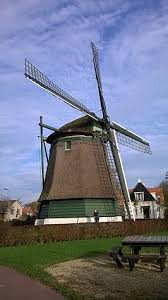Source:www.molendatabase.nl
The mill Lastdrager is undoubtedly early 17th century, built as a corn mill octagonal smock.
It seems that the first mill to Hoogwoud built around 1608. The States of Holland granted on July 6 of that year license to Cornelis van Mierop, Ambachtsheer of glory and High- Aartswoud do a wind mill bemaalen uijtsluitend unto gerieff of the ingesetenen. Whether this concerns the current mill is not clear. On a map published in 1680 stands on the site does show a flour mill.
In 1827 the mill was bought by Cornelis Bos Corneliszoon without specific heroep and from Terschelling. Descendants of him were later miller Koedijk and Schagen.
The name of the load carrier is apparently quite old, because he has been named as the mill is sold within the Bos family in 1855.
In 1935 binnenroe is broken, and the mill is out of service. The depth works are then removed and the empty shell of the mill is then used only for storage. The animal feed and milling operation was continued for standing in a barn in addition to the mill with a pair of millstones, which came from the mill and was powered by a diesel engine. The mill has for some time been one rod and no tail. Later, outside long rod and shoot away.
In the mill 1957 has been restored externally, using from Groningen second rods. In 1968 he was bought by the municipality and transferred the following year to the current owner. In the years 1971-1972 was carried out a major restoration and mill again occasionally operated since 1977.
Construction
The relatively lightly built predominantly oak and eight side is without a sub table element on two by two parallel-arranged piers. It is noteworthy that the two field crosses, which are present in each field have been working with the ends into each other. In addition, the two truss layers consist of free-apart alloy beams.
Also notable is that two steps are not made from oak but of pine located octagonal styles next to each other. No doubt this is related to a major recovery. Presumably, had the year 1865 relating thereto. This repair was, after all, are not practicable to remove the spot without the rietdek.
Apartment above table, rolvloer, cockpit and canopy are already renewed, probably in the 18th century (1732?). Probably on that occasion the mill changed into an external turning.
On one of 1726 dating engraving is at least he still clearly drawn as internal turning.
Until decommissioning were three pair of millstones, which were at one time seat on the main floor.
